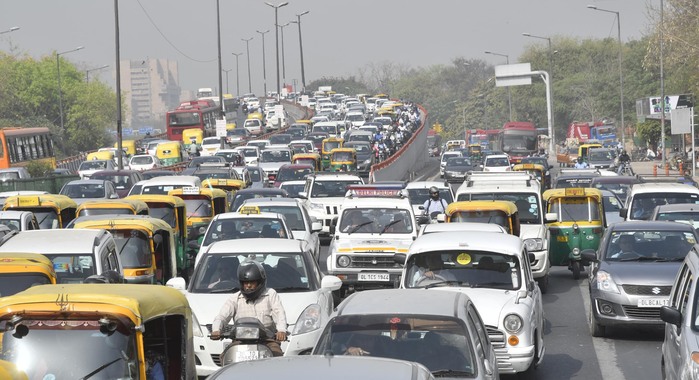The government body says India has the enabling factors like entrepreneurial skills, confluence of information technology and manufacturing skills and public- and private-sector leadership to lead the world in advanced mobility services.
‘India Leaps Ahead: Transformative Mobility Solution’, a joint report produced by NITI Aayog and Rock Mountain Institute, says accelerated adoption of electric and shared vehicles could save $60 billion in diesel and petrol costs while cutting down as much as 1 gigatonne (GT) of carbon emissions for India by 2030, says a joint report released today by Niti Aayog.
It adds, however, that the country faces challenges that signal the “gravitational pull of privately owned vehicles”. The report estimates that India can conservatively save up to 64 percent of anticipated passenger mobility-related energy demand and 37 percent of carbon emission by 2030.
“By 2030, this would result in an annual diesel and petrol reduction of 156 million tonnes of oil equivalent,” said the report,“At current oil prices, this would imply a net usual fuel cost saving of approximately 3.9 lakh crore by 2030,” the report added, says PTI. Releasing the report, NITI Aayog CEO Amitabh Kant said whether one likes it or not electric vehicles (EVs) will happen in India.
The challenge is how we do it quickly. How do we do it to scale and size,” he said.
Noting that the cost of batteries is falling by about half every five years, he said that as a result in the next 4-5 years, EVs even with batteries would not be far more expensive than petrol or diesel vehicle, while operational cost will be just 20 percent of that of a petrol vehicle.
Stressing that the government is fully committed to driving this electric vehicles programme, Kant said EVs will come into India in a big way in about a decade. “But the challenge is if we delay it then we will end up importing batteries instead of oil and it will be difficult for us to take leadership,” he cautioned.
“So we should drive our own EVs programme, which will enable us to manufacture EVs,” Kant added. He also pointed out that quick volume alone will enable India EVs programme to succeed.
“And therefore aggregation of demand on a large scale is important. Its important that government drives it by focusing on government vehices and public vehicles,” Kant said
New mobility paradigm
India’s current mobility system reflects many of the underlying properties of this new mobility paradigm. These elements include a high share of non-motorised transit, low private-vehicle ownership, a diverse set of mode options, and strong IT capabilities. As India continues to develop at a rapid pace, it is essential to maintain and invest in these attributes, as they serve as the foundation of a shared, electric, and connected mobility system.
This starting point enables India to leapfrog towards ambitious goals of 6-7 million xEVs by 2020 and 175 GW of renewable energy by 2022. Niti Aayog says today, many of the technologies and business models that support this vision are already cost-effective, high-quality, and convenient. For example, many HEVs, PHEVs, and battery electric vehicles (BEVs), which represent a progression of increasing intensity of vehicle electrification, are becoming cost-competitive and can become more so through bulk procurement of their common assembly- and subassembly-level parts. The affirmation of the NEMMP-2020 roadmap and continuation of the FAME scheme are important indicators for OEMs that play critical roles in bringing more xEV products to the Indian marketplace.
Three-phased strategic plan from 2017-2032
Niti Aayog and RMI have drawn three strategic phases covering the action plan for next 15 years, until 2032. These include:
Phase 1 (‘Notching the Arrow’, 2017–2019) prioritises solutions that are already economic and capable of rapid scaling, while cultivating solutions that are nearly economic.
Phase 2 (‘Drawing the Bow’, 2020–2023), opportunities that were introduced in Phase 1 are being refined and scaled, while the options that were previously identified as nearly economic have become cost-effective and ready for deployment. Simultaneously, public- and private-sector action continues to lay the groundwork for enhancing the economics and feasibility of future opportunities.
Phase 3 (‘Letting the Arrow Fly’, 2024–2032), more opportunities become economic and scale to the national level. Emerging ideas follow this same trajectory, while systemic solutions from lighthouse examples help integrate technology, design, and business models at a national scale.
Too ambitious a project?
The Niti Aayog report says with collective ambition from stakeholders across the private sector and government, India has the potential to turn this green mobility vision into reality and emerge as a global role model in advanced mobility solutions.
Chetan Maini, who was part of the two-day workshop a couple of months ago, says this time around there has been a very good collective effort of a varied number of stakeholders to build a conducive eco-system for electric mobility to be a reality in India.
Opportunities for India automotive
The workshop organised in New Delhi on February 27-28 saw participation from senior government officials from concerned ministries, representatives from the private sector (auto and mobility sectors, banks and financial institutions), civil society, academia and NGOs.
A total of 75 key participants chalked out 12 detailed opportunity areas for action, which can also serve as the building blocks for India’s shared, electric and connected mobility future, at the two-day workshop.
Among all the opportunities, three themes stand out for their overarching impact. These include scaled manufacturing (to create xEV supply), shared infrastructure development (set up supportive ecosystem for pedestrians, cyclists and passengers) and system integration (build demand and enhance efficiency through data sharing and policy frameworks).
According to the report, these three themes lend structure to the list of actionable solutions, clarify the implementation approach and provide a framework for ongoing discussions and debates.
Here’s taking a closer look at some of them, as depicted below:

